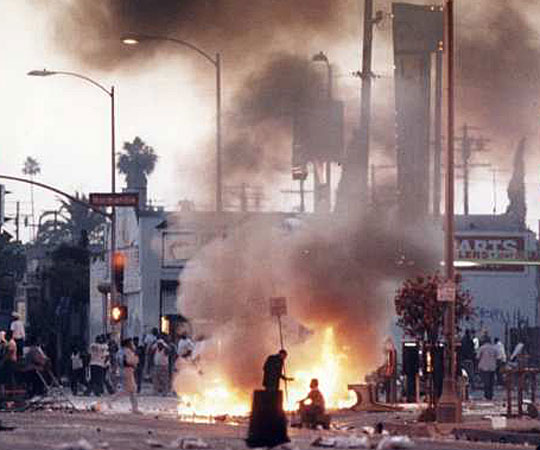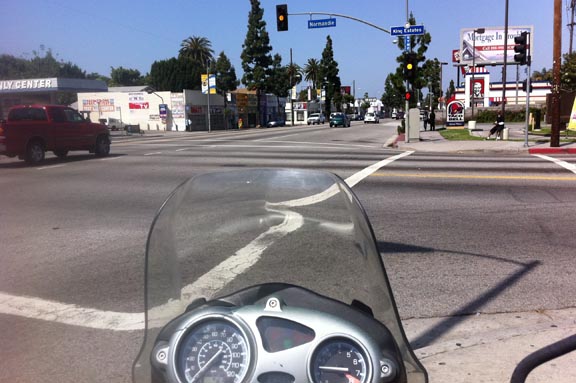Last week’s media coverage of events in Los Angeles 20 years ago shouldn’t obscure the fact that the city still has major issues to address – even after the news cycle has moved on. This week are are re-posting articles from two newspapers which, unless you are within the communities they serve, you probably don’t read. The following article is from Our Weekly; we have also posted an article from the K-Herald. – A.L.
Twenty years ago, Los Angeles exploded into flames and violence after one Hispanic and three White police officers were acquitted in the videotaped beating of Black motorist Rodney King.
During the event—variously called a riot, civil unrest, rebellion and revolution and feuled by the same anger at an “unjust” judicial system that was at the heart of the 1965 Watts Rebellion—more than 2,000 national guard troops were deployed; the marines were called into action from Camp Pendleton; curfews were imposed in L.A., as well as in the surrounding cities of Carson, Culver City, Hawthorne, Hermosa Beach, Huntington Park, Inglewood, Torrance and West Hollywood; an estimated 1,000 buildings were burned; thousands were injured; the region-wide property destruction was an estimated $1 billion and 53 people lost their lives.
OurWeekly went back to one critical flashpoint of the violence—Normandie and Florence avenues—to talk to people who lived and continued to live in the area or frequent it, to ask if they have seen a difference.
Yes and no.
There is no real consensus about whether life is better or worse since 1992.
“Really it’s changed for the worse,” said 41-year-old Erik Patt, who was born in the area and grew up there in the 1970s.
“In the ’70s, these were very nice neighborhoods,” Patt pointed out as he got his car repaired by a local mechanic the week before the anniversary. “All these bars (on homes) were not here. The houses had plate glass doors. Now, there’s no money; the school system is horrible.
“There’s nothing new, except those businesses on the other side of the liquor store,” Patt continued, pointing to a Subway, Metro PCS and fashion boutique on the north side of Normandie Avenue.
The budding entrepreneur who says he’s working to start his own trucking company also pointed to the lack of jobs as a key continuing problem for the neighborhood, and noted that his grandmother raised his parents in the area while working at places like the McDonnell Douglas Corp. “Those jobs are gone now.”
“The only thing that’s changed is the Auto Zone; it used to be a Kragen,” said 83-year-old retired Los Angeles Unified School District Employee Adolph Washington, who has lived near 78th and Normandie since 1963.
Both Patt and Washington were among the numerous people who also noted the demographic shift in the last two decades.
“When I moved here, it was half Black and half White,” recalled Washington, who also noted that on his block crime has quieted down and been cleaned up—the crack house has been closed down.
Anthony St. Julien was born in the area of Normandie and Florence, grew up in Leimert Park, and was the service manager at the old Pep Boys on Crenshaw Boulevard in 1992. He remembered that after the verdict a car plunged through the door of the store.
“A lot of the buildings have been replaced; the cops are a little better, but a lot of the things are the same. There are a lot of empty lots,” St. Julien said.
What he would like to see is fewer fast-food restaurants and more of other kinds of businesses.
D. Abrams thought the Normandie/Florence intersection is more bustling now than 20 years ago. She also felt the area seems to be on the upswing; and said there are more small businesses providing services, but pointed to the lack of stores such as supermarkets.
Abrams, who lives near Slauson Avenue and Avalon Boulevard, and stops for gas at the stations on Normandie and Florence, believes there was less homelessness 20 years ago.
What she would have liked to see change is more jobs and training for Blacks.
Renita Polk, 56, who’s been living in the area a little more than 20 years, offered her memories of the day: She didn’t see the debacle but did see “a bunch of policemen and a bunch of folk in the street.”
“I packed up my clothes and got away,” she said laughing. “I went to my mother’s house in Compton. I didn’t see when they got him (Reginald Denny) out of the truck or anything.”
Polk said she returned home three or four days later. “I had to leave,” she said.
After she returned, Polk said the police knocked on her door and asked if they could come in. She said no.
Even several days after she returned, she said people were throwing rocks at the police. This was occurring even in the middle of the day.
In his state-of-city-address last Wednesday, Mayor Antonio Villaraigosa remarked on the economic malaise that has settled on the city.
. . . “We have 720,000 Angelenos living on the wrong side of the poverty—a city the size of San Francisco. We must take up the vital mission of bringing the benefits of economic growth to every part of Los Angeles. If our economy is to work, it has to work for everyone.”
Remarking on the 1992 explosion, the mayor said, “The death and damage of those six days finally forced us to come to grips with the hard truth: L.A. was a city divided.
. . . “Los Angeles of 2012 is a different city. The Los Angeles of 2012 is a better city. Somewhere in the heavens, Tom Bradley is smiling. In the two decades since those six days in April, we forged a new partnership between the LAPD and the community based on respect. We changed the culture of policing in L.A. and enshrined constitutional policing as the bedrock principle of the LAPD. We recruited a new generation of officers. We now have a force that reflects the many different communities it services.”
Marqueece Harris-Dawson, president and CEO of Community Coalition (CoCo), which was entering it second year of existence when the violence broke out, summed up the situation this way: “The things that haven’t changed are so bad and so ridiculous that they cover up what has changed.”
Like Villaraigosa, Harris-Dawson, pinpoints the community-police relationship as a better one than 20 years ago. He said the relationship between Blacks and other ethnic groups in the area has also improved.
But these gains have essentially be obliterated by an economic situation that has spiraled out of control.
“Unemployment or underemployment is as bad or worse than 20 years ago,” noted Harris-Dawson.
The CoCo CEO said there has also been a divestment in South L.A. that has not been helped by economic development efforts that don’t force the issue of investing in underserved areas of the city.
“Economic redlining sponsored by financial institutions makes the situation in South L.A. worse,” said Harris-Dawson, who remembered former Federal Reserve bank head Alan Greenspan walking the vacant and burned out lots in South L.A. and promising re-investment.
Twenty years later many of those lots are still vacant and still desolate.
In 2005, the Los Angeles Urban League teamed up with the United Way to create a groundbreaking report called “The State of Black Los Angeles.” At the center of the study was something called an Equality Index that measured the equality of conditions for ethnic groups in L.A. County.
African Americans, as usual, came in at the bottom with a 0.69 compared to 1.00 for Whites, 0.98 for Asians and 0.71 for Latinos.
Five years later in the 2011State of Black Los Angeles, Blacks remained at the bottom, barely moving above that first year’s number—0.71 compared to 1.03 for Asians, 1.00 for Whites and 0.72 for Latinos.
Changing the economic dynamic in Black Los Angeles requires government entities to step up to the plate to make if more costly to redline than to invest, believes Harris-Dawson.
But the community activist added that the problem may not be soluble in Los Angeles. Some people think it must be fixed on a much larger scale, said the CoCo leader, but he is also convinced that Los Angeles must lead the charge in trying to correct the economic system.
And the so-called millionaire’s tax should be the rallying point for the turnaround effort, asserted Harris-Dawson.
“What it does (if passed) is stops the bleeding and keeps us from going backward, which is what we are doing at this moment.
Harris-Dawson also agreed that a stick, and a willingness to use that stick “in a cooperative way and—in an oppositional way—is needed.”
“We need to put pressure on retailers so we can get grocery stores in South L.A. and East L.A. If they want to open their eighth store on Wilshire Boulevard, the city should say ‘in exchange for these permits for Wilshire, you have got to invest in South L.A. and East L.A.’”
While the economic situation overshadows much of what has been accomplished in South Los Angeles, without a doubt, there are some bright spots. These include:
•The building of Chesterfield Square Shopping Center at the intersection of Western and Slauson avenues that boast stores such as Jamba Juice, Starbucks, IHOP, Food 4 Less, Home Depot and Walgreens. It was completed in 2004.
•The renovated Baldwin Hills Crenshaw Plaza reopened with the 15-plex Magic Johnson cinema in 1995 (now called Rave Cinema); and then in 2003 Walmart opened its first three-level store in the old Broadway department store site.
•The opening of a Fresh & Easy grocery store on the historical Central Avenue corridor.
Change has happened since 1992, but much more is needed. On that everyone agrees. How to get there is the question.
Re-posted with permission from Our Weekly.
Images: Top, Normandie and Florence 20 years ago; below, the same intersection today.


